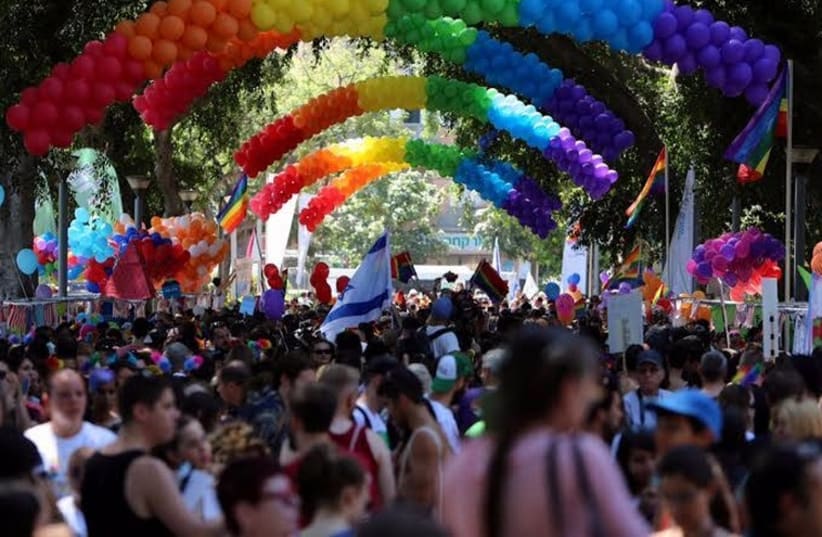
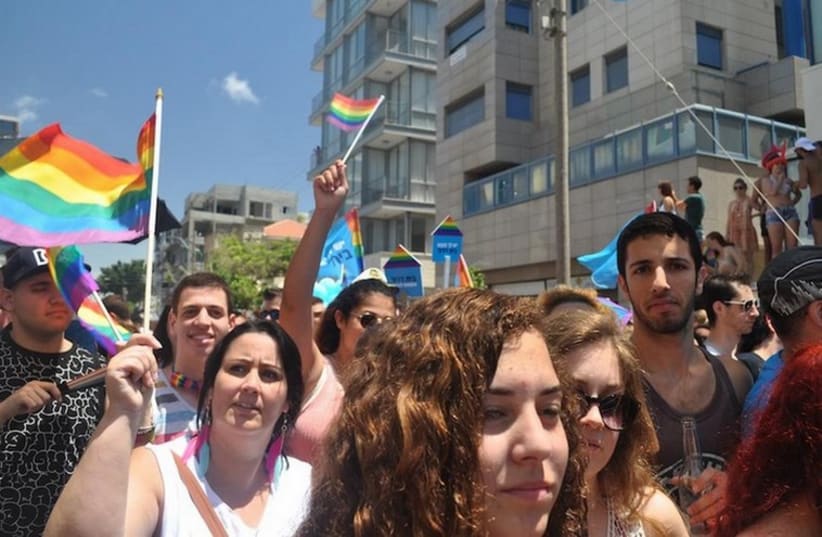
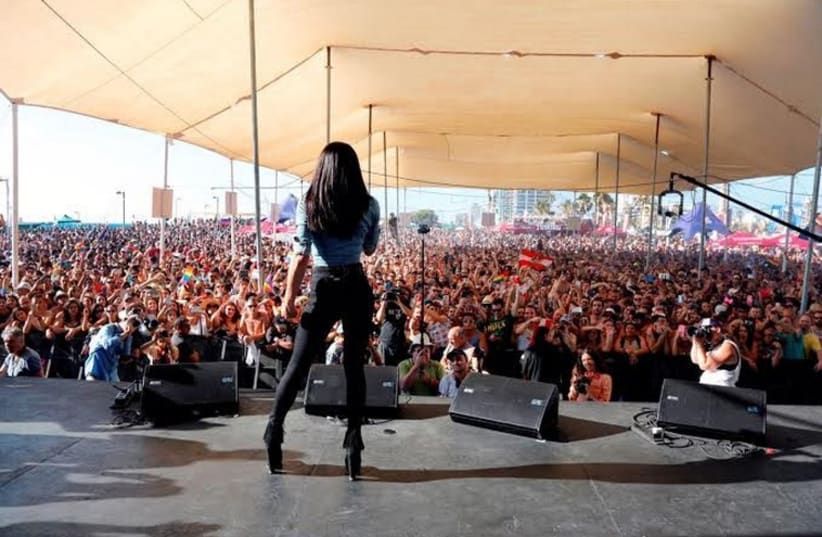

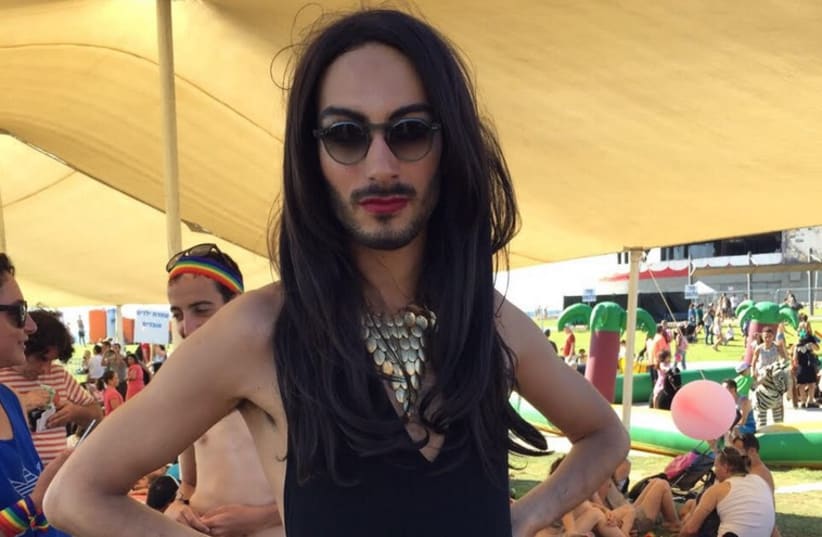
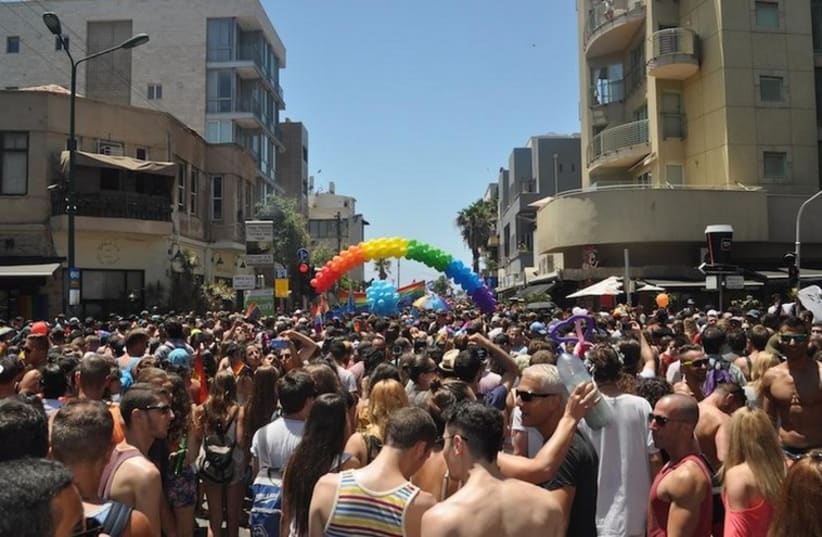

The merriment of the revered yearly festivity began Friday morning with a gathering party at the tree-lined Meir Park, where the municipal lesbian, gay, bisexual and transgender center is located, and kicked off around noon with a record-breaking 180,000 participants marching in support for the LGBT community.An infectious party spirit radiated as good-natured masses of all genders, orientations, ages and nationalities flooded the roadways bearing the rainbow colors of the LGBT movement, dancing and waving banners calling for equal rights and legitimacy. Members from the right-wing Likud and left-wing Meretz parties were also visible with large billowing flags.About 30,000 tourists hailing from international locations such as Brazil, Austria, Belgium, Spain, Sweden, the US and the UK partook in the largest gay pride event in Asia, and one of the only in the Middle East.Road crossings zebra stripes were painted in bright rainbow colors, matching pride flags hung proudly at nearly every other storefront and off of countless balconies.Support for the LGBT community, often marginalized in many cities abroad, was unwavering in Tel Aviv.Steve Wengrovitz, 31, a first time attendee at Tel Aviv’s pride week visiting from San Francisco, noted that it was impressive to see so many businesses in the city promoting pride with flags and regalia.“Seeing the whole city turn around and open up for pride is special,” he told The Jerusalem Post. “It’s striking for a relatively conservative country, and a religious one, to have such openness and visibility of pride.”He added that the attitude toward the LGBT movement in the coastal Mediterranean city showed “Tel Aviv as an anomaly for Israel, and on a greater scale, Israel as an anomaly for the Middle East.”Along with all the glitz and jubilee pervaded a strong sense of freedom that attendees had not always enjoyed. John, who is originally from the US but has lived in Moscow for the past 18 years, has been flocking to Tel Aviv for pride week for the past fives years with friends from Russia, where he explained that the general situation for the LGBT community is not as accepting as in Tel Aviv.“We’re really happy the country is open to having us, it’s amazing because in Russia you could never have something like this, it’s forbidden by law,” he told the Post.“Everyone here is happy, it’s amazing. We’re so glad to be here and we’re so happy that the government supports us,” he raved. John and his handful of friends – men covered in gold glitter, donning four-inch floral high heels, military style berets with Russian insignia and speedos under red-and-yellow aprons decorated with pictures of traditional Russian nesting dolls – explained that they would not be able to wear such outfits in Moscow.John, who did not provide his last name for security reasons back home, expressed hope that the flourishing, albeit largely underground, LGBT population in Moscow would one day become more understood by the general population.The march was led by a series of floats making their way slowly south on Hayarkon Street, along the coastline and beaches where thousands were retreating to cool off. About a dozen themed floats, featuring mostly scantily clad performers, blasted music as nearby pride-goers danced enthusiastically in the summer sun.Kul L. Kolton, a native Israeli, wanted to show something different on the float officially sponsored by the Tel Aviv LGBT Center.Highlighting this year’s pride theme held under the banner “Tel Aviv Loves All Genders,” Kolton’s float featured mainly transgender dancers and rectangular turnstile structures with cubes that could be turned to show different combinations of gender variant faces, torsos and lower body parts.“The trans float says a lot about what other people see and what is acceptable,” Kolton underlined, adding that its message set it apart from other sponsors’ floats that carried few lesbian performers and mostly homosexual men who were “very sexy and very waxed.”While transgender and transsexual people still seemed to be a minority at the parade, the event’s focus on that community was markedly celebrated.Even Kolton, who identifies as genderqueer, noted the well-representation of the transgender community at the parade. Still, she said that although awareness seems to be “evolving very fast” in Tel Aviv, the discussion about gender and sexuality still has a long way to go outside Israel’s second-largest city.The focus on transgenderism was a drawing factor for the headlining performance by Austria’s bearded diva Conchita Wurst at the enormous beach rave where the march finished at the seafront Charles Clore Park.The jovial energy continued into the late afternoon at the ending party lined with sponsor tents and packed with party-goers dancing to thumping techno beats at a concert emceed by gender-bending entertainer Uriel Yekutiel. The program also included a special performance by Israel’s Eurovision “Golden Boy” contestant Nadav Guedj.Heads turned as a lanky Conchita look-alike, who goes by the performance name Shiaz Legz, entered the premises wearing black pumps, a matching leotard, and exquisite facial makeup framed by a manicured, dark beard and long brown hair.“Here I feel it’s one pride, everyone is together and it’s all about equality,” said the Switzerland native who now lives in Berlin. “I feel very welcome here and I hope that everyone who is gay, lesbian or transgender feels very welcome here.”Countless Israelis flocked to Legz for photos, mistaking her for the legendary Conchita herself.“You do know I’m not the real Conchita, right?” She assured, before marching onwards on the grassy lawns, her frame growing more distant and disappearing in the horizon.